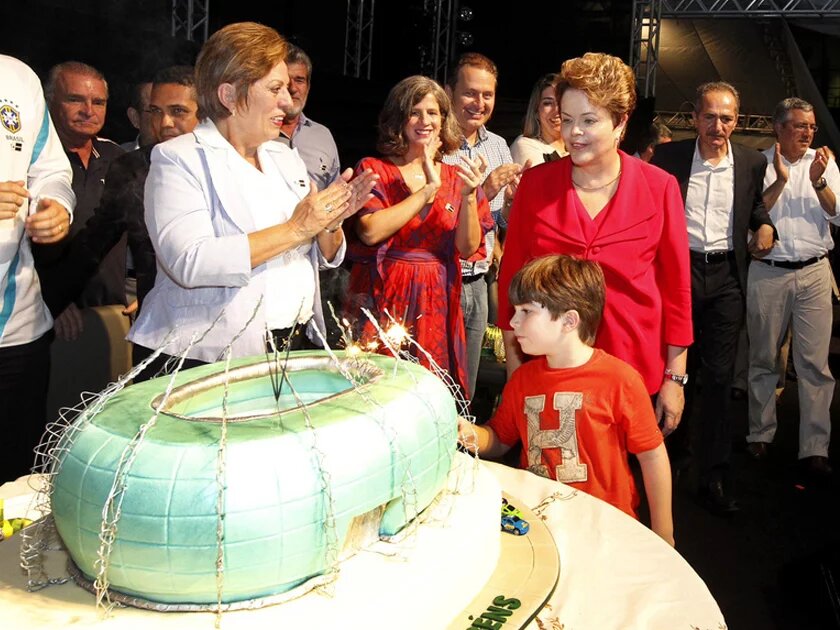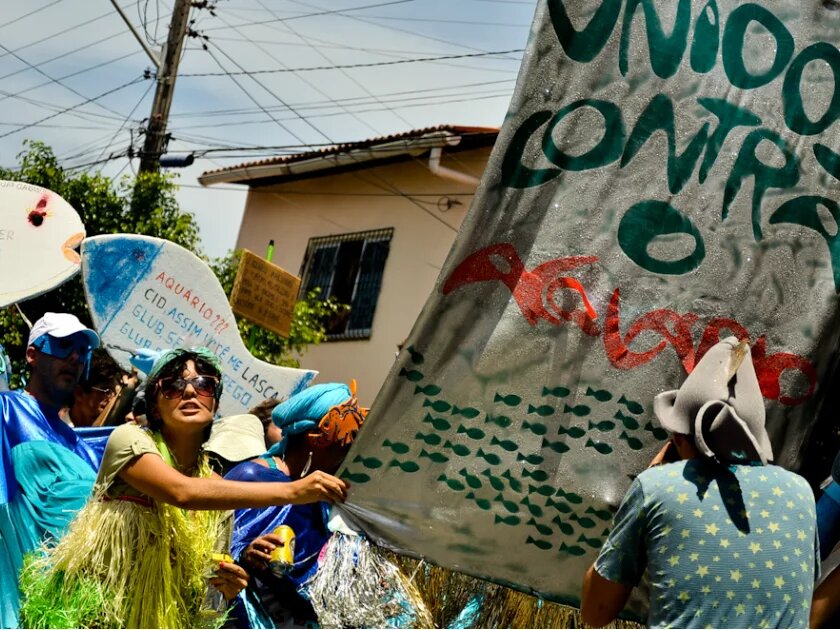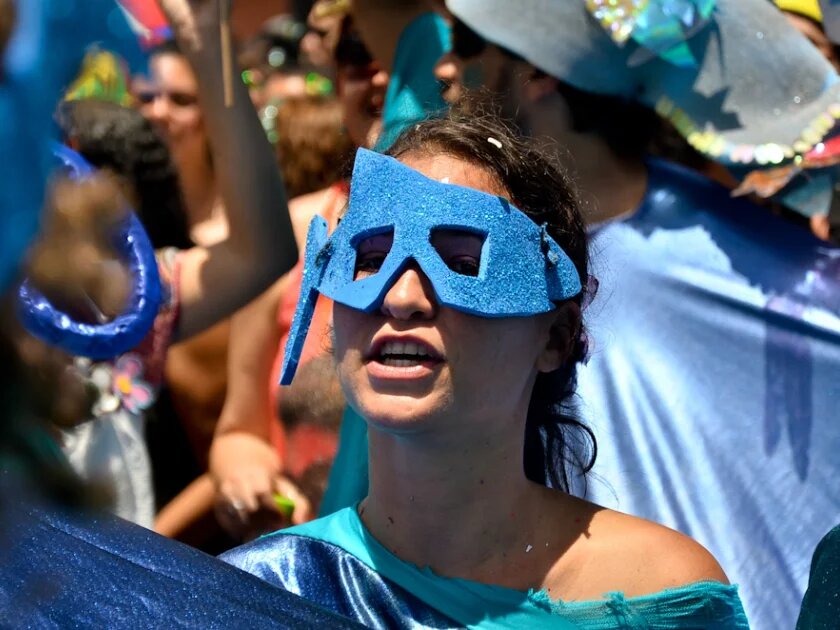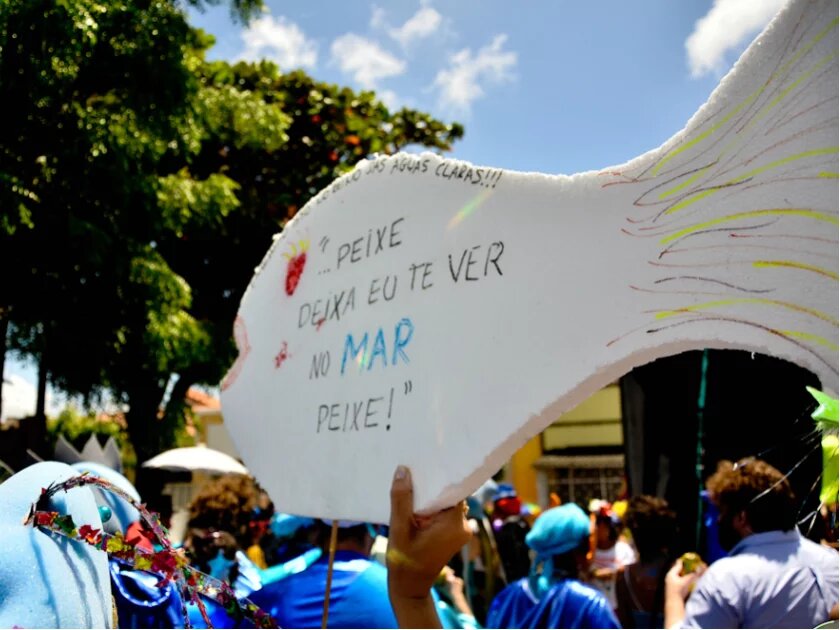

Fortaleza is the capital city of Ceará state in Brazil's northeast. With more than 2.4 million inhabitants, it is one of the most sought-after tourism destinations in the country and the fifth largest city in Brazil. Among its main attractions are its seashore and the almost year-round sunny, warm weather. Social inequality, though, is a frightening factor: In contrast with the luxury hotels on Iracema Beach, residents of the poorer quarters suffer with the violation of their most basic rights. For instance: 43 percent of the city does not even have a sewage disposal system.
One such area is the Poço da Draga community, in the vicinity of a great state building, Acquário Ceará. Under the justification that the aquarium would increase tourism in the capital, more than R$280 million (approximately US$126.8 million) was spent on the building, which led to the popular movement "I wish I were a fish," which disputes the great amount of money being spent and the irregularities of the project. The movement’s name makes reference to a song by a pop singer from Ceará, Fagner, and implies that the animals that will live in the Acquário will be better treated than the poor human population of Fortaleza.
Another substantial investment recently made in the capital was for the renovation of Plácido Aderaldo Castelo Stadium, better known as Castelão, which cost more than R$518 million (US$234.6 million). The construction work was part of the preparations for the 2014 FIFA Football World Cup. Castelão was the first stadium to be ready for the tournament and will host six matches, including Brazil vs. Mexico on June 17, and Germany vs. Ghana on June 21.
Also part of the preparations for the Cup are the construction projects related to urban mobility, which have led to many forced removals in Fortaleza. The event might also increase sexual exploitation – a serious problem that afflicts the city, which is part of the route for the international trafficking of people. With these and other elements, this report offers a portrait of Fortaleza, one of the World Cup's host cities.
A Community in the Way
In order to be allowed to host the World Cup, the candidate countries commit to improve their urban infrastructure and to adjust their services and other items to the quality standards demanded by FIFA. In Brazil, the projects for this involve the removal of entire communities, uprooting families from their original homes. The City of Fortaleza's Popular Committee for the Cup is one of 12 such groups that has been established around the country since 2009 to fight against the rights violations involved in the process. The mobilization gave rise to the creation of the National Articulation of the Popular Committees for the Cup (Ancop), a collective of organizations, social movements, and people affected by the preparations. As the journalist Roger Pires, a member of the Committee in Fortaleza and of Nigéria Communications, Audio and Video (a Ceará-based independent collective), explains: "It is the Cup that nobody sees," he says. "We have denounced the development model adopted by the federal government; one that preaches economic growth, but tramples the environment, the people, and disregards the future."
According to him, the authorities do not clearly divulge the number of families being removed to make way for the event but only publish estimates. In Fortaleza, according to the Committee, there are 5,500 families that have been either removed or threatened with removal. In total, that would mean 20,000 people, including the communities of Alto da Paz, located in the Vicente Pinzón neighborhood, and the community from the Serviluz neighborhood. These communities are going through removal processes justified by the need for construction projects that are not part of the official Cup-related projects. The plan for those places is to build new residences – a proposition questioned by housing-rights experts, according to information taken from the report of a public hearing promoted by the Housing Center with the Ceará State Public Defender Office in February. In Brazil, a total of 250,000 people either have been or are being removed from their homes, voluntarily or not, according to Ancop's estimates.
The difficulty in finding the actual number of removed families is also emphasized by Patrícia Oliveira, an attorney with the Rede Nacional de Advogados e Advogadas Populares – Renap (National Network of People's Lawyers): "It is a very mutable thing. Sometimes, within a judicial bidding process, they change the numbers and do not inform exactly how many people should be removed." According to Oliveira, the inconsistency of this data ends up weakening the community's resistance.
She believes the government's intent is to always remove more families than necessary. Besides, there is no communication between the government and the residents who will be directly affected by construction work. Oliveira is also critical of projects that were kept on hold, but are now moving forward to take advantage of the general climate of anticipation for the mega-event and end up being included in the "preparations package." She sees this as a "big political game to inject money into the economy and favor those who are already making big profits with the event, such as building and tourism-related companies."
The legacy is also questioned by the lawyer. "The event did not even begin yet, and the population has already understood that there won't be much left for them afterwards," she says. She believes that many construction works will not be completed until the beginning of the event, including the VLT (Light Rail Vehicle), one of the most ambitious promises made by the state government.
A Strong Resistance
The craftsman Ivanildo Lopes is one of the leaders of the Lauro Vieira Chaves community, located in the Vila União neighborhood, where he has lived for 47 years. His community is one of 22 in the path of the VLT. In July of 2010, Lopes, who was born and raised in the neighborhood, received a letter from the government of Ceará summoning him and other residents for a meeting. During the meeting, they were informed that their houses had been photographed and measured, and that they would be removed from the terrain so that construction work could begin.
"We got together immediately to argue those conditions because we had not been called to discuss anything with the government, we were simply informed of what would happen. And they wanted to pay too little [as compensation] for the houses," recalls Lopes, who also says that some of his neighbors received offers as low as R$3,000 (approximately US$1,354). His house was appraised at R$12,000, but since there is no deed for the land, he would only receive R$8,900. Both amounts were inferior to the owner's expectations of R$40,000. "My house was at an avenue, and that alone adds value to the property," he argues.
Those houses have already been torn down, and the construction for the VLT is underway. On the other hand, Lopes celebrates at least three victories for the community over the last four years: the government has changed the VLT project, reducing the number of removed families. The owners of houses valued at up to R$40,000 have won the right to an apartment, free of charge, in addition to the compensation. The third victory was that the new apartment has to be in the same neighborhood where the community used to be, and not almost 10 miles away, as stated in the first proposal. "We have discovered a vacant lot three blocks away that belongs to the city. Then the state and municipality made an agreement, and now they are building the apartments, which will be ready in 2014," says Lopes.
For the student Gabriel Matos, 14, also a resident of the Lauro Vieira Chaves community and a member of the People's Cup Committee, the mobilization is vital in giving visibility to what happens in the affected communities. He creates content for a blog, as well as videos with interviews made with residents. His material is shown every month at a movie club, improvised in the street for children and teenagers from the neighborhood. Matos' house was marked to be removed at the beginning of the VLT project, but it was saved by the changes that took place later. For him, someone who loves soccer and intends to cheer for Brazil during the matches, the mega-event is no reason to celebrate: "It doesn't matter whether the Cup will happen here in Fortaleza or in China. My family and I have no money to buy tickets and go to the stadium, so we will only watch it on TV anyway," he says. "For us, this Cup's legacy is only sadness."
The Infrastructure Office of Ceará (Seinfra), through its press secretary, reported that an estimate 2,185 properties will be expropriated for the VLT construction. But this number changes almost daily, due to project changes, details not yet made, and reports issued to the reluctant communities, among other factors. The initial forecast contemplated 3,000 removals. The number of affected properties is not the same as the number of families that receive compensation because there are landlords, tenants, squatters, occupants, and other beneficiaries.
Giant Budget for the Worlds Biggest Aquarium
The amount invested in the VLT, according to the office, totals R$273.9 million (US$123.16 million), which is R$8.4 million (US$3.78 million) more than what was initially estimated. There were predictions that the transport system would be operational on May 31, 2014 – in time for the World Cup. The project, which began in April 2012, should have been finished by the end of 2013. As for the urban mobility construction works for the World Cup, which is the responsibility of the municipality, they total R$292.42 million (US$131.48 million) in investments and 585 forecasted removals, according to the city of Fortaleza. BRT (Bus Rapid Transport), the project closest to being finished, on Alberto Craveiro Avenue, is 97.9 percent ready. The slowest project, the Dedé Brasil Avenue BRT, was only 9.11 percent finished in May. The city's new goal is to complete 10 percent of the project (which began in September 2012) by the start of the World Cup and to finish the project in 2015.
Additions to Pinto Martins International Airport and the Port of Mucuripe, both projects of the federal government, are not yet finished. According to INFRAERO, the Brazilian Airport Authority, there are two phases to the project – one that should be operational before the Cup, and the other in 2017. According to recent statements by Civil Aviation Chief Minister Moreira Franco, the terminal is the only one in the country that will need an alternate plan because it will not be ready before the Cup. To receive passengers during the tournament, a temporary, remote terminal, which cost R$1.7 million (US$760,000) in public money, will remain active for 90 days. The investment in the first phase of the construction and the makeshift terminal total R$170.88 million (US$76.83 million).
According to the Port of Mucuripe Press Assistant, in February 2014 the additional construction was 86.2 percent finished and promised for May. The amount invested was R$205 million (US$92.18 million).
Democracy at stake
Fortaleza was one of the cities that actively participated in the protests of 2013, also known as the "June Journeys." In the conflicts between protestors and the police, vinegar became a remedy against the effects of teargas, and its possession was treated as a crime. According to a report by the Citizenship and Human Rights Commission following the protests in Fortaleza on June 20 and 27, there were 163 people arrested.
Patrícia Oliveira, Renap's attorney, points out that many of the arrested were minors, and that the detentions were marked by police brutality. Fourteen adolescents were arrested on June 20 alone, without motive, by officers without any identification, some of them in plain clothes. When asked for their IDs, the policemen refused to provide any. The report also denounces abusive behavior by the officers, which ranged from physical and verbal aggression to the sexually inappropriate frisking of a young girl by the military police, even after she requested that the body search be done by a female officer. The lawyer believes that, although many of the abuses were committed by the policemen, much of what happened is actually institutional, because it is part of the police strategy to stifle the protests.
The documentation created by protesters with cameras and cell phones flooded the internet. While covering the demonstrations in Fortaleza on June 20, the journalist Pedro Rocha, from Nigéria Collective, was shot in the eye with a rubber bullet. On the day of the Confederations Cup semifinal, Rocha, who had partially recovered from the injury, was back on the streets covering the conflicts. He was arrested in the vicinity of Arena Castelão, the stadium in Fortaleza where the Confederations Cup games were held and where World Cup games will be held. He was with a coworker and other protesters when the police approached them. "They stopped a group of us and threatened to shoot us pointblank – and, indeed, one of the protesters was shot – cursed at us, told us to empty our backpacks and then put us with others," reports Rocha. Records of June 2013 led to the documentary film With Vandalism, available at the Collective channel on YouTube.
After the Confederations Cup, there was police repression during other events that occurred in Fortaleza. "We had cases of peaceful protests after the Confederations Cup that were also suppressed with rubber bullets and teargas, and this goes to show that our country has never really left behind the dictatorship of arbitrary characteristics," says attorney Oliveira. She also draws attention to the funds invested in ordnance for this repression, which remains undisclosed by the government, funds that could be invested in much-needed health, education, and decent housing for the population of Fortaleza.
This reporter contacted the Ceará State Public Security and Social Defense Department to discuss the allegations made last year and about the security strategies for the 2014 World Cup, but no answer was received. On that occasion, the department also did not comment on the investments made in non-lethal weaponry.
Risks of abuse, sexual exploitation, and human trafficking
Fortaleza has high rates of sexual abuse and exploitation, besides being one of the main routes of international sex tourism and human trafficking in Brazil. With the World Cup, the challenge of fighting these crimes is even greater: As if the arrival of tourist was not enough, there has also been an increase in the male population with the many builders engaged in construction. The United Nations Program for the Environment predicts that the World Cup will generate an increase in the number of tourists who annually visit Brazil, from 5.5 million to around 7.2 million. According to the Survey on Women, Children and Adolescents Trafficking for Commercial Sexual Exploitation in Brazil – the largest study ever performed on human trafficking in the country – Fortaleza is among the main places of origin for trafficking victims. In Ceará, the Department of Justice Center for Fighting Human Trafficking identified 22 cases in 2013 and three cases in 2014.
According to Magnólia Said, an attorney and technician with the Esplar Research and Advisory Center, the mega-event can create more opportunities for criminals, and one reason is that the safety net for victims across the state is fragile and scattered. The machismo culture, still prevalent in the country, pitches the beauty of Brazilian women as a product, part of the tourism package. The socioeconomic fragility of the population also contributes to this situation.
"Trafficking is directly linked to poverty, which makes the northeast even more vulnerable," says Said. Ceará ranks 17th in the Human Development Index among Brazil's states, according to the 2013 Atlas of Human Development in Brazil. To Said, a radical change in education is necessary to increase women's self-esteem and empowerment, as well as to promote more egalitarian gender relations. However, according to the attorney's assessment, the investments for ending these problems are low, weakening the current programs and plans, and resulting only in specific actions. "During Carnival, we can watch a TV commercial and see some posters encouraging people to report this kind of crime, but what about afterwards? We need to do much more in order to change this reality, we need to work on this issue together with the population, in schools and in the media, throughout the year," she says.
Sara Luiza Moreira, member of the World March of Women and team coordinator of ESPLAR, says the mega-event can be an incentive for women from rural areas to come to the capital and become prostitutes. "We hear about girls planning to get pretty for the World Cup, who want to come to the capital to work and send money to their families. We worry that they might end up becoming victims of abuse," explains Moreira, adding that the dream of finding a Prince Charming and a better life abroad also feeds the imagination of girls and women, which can make them victims of human trafficking.
For Said, the abuse-reporting and victim-protecting system in the state is disjointed, fragile, and inconsistent. "Sometimes the same authority who receives the reports of violence, abuse, exploitation, or trafficking discourages the victims or even blames them," she criticizes. "In Ceará, there are only nine Specialized WPS. According to state law, they should be present in at least 23 municipalities."
The press assistant for the Policies for Women Coordination, with the Citizenship and Human Rights Department, stated that the agency is developing policies for women as well as action plans to prevent and fight violence (human trafficking among them), in accordance with federal plans and programs.
Translated by Fal Azevedo.

